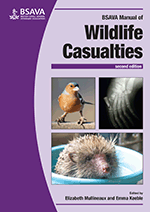
Full text loading...

This chapter provides information on appropriate first aid and emergency care for most wildlife species in the UK. Primary assessment and emergency treatments for shock and dyspnoea are covered. Sections on fluid therapy, nutritional support, emergency medication and the treatment of traumatic injuries and poisoning are also included.
First aid and emergency care, Page 1 of 1
< Previous page | Next page > /docserver/preview/fulltext/10.22233/9781910443316/9781910443316.5-1.gif

Full text loading...








